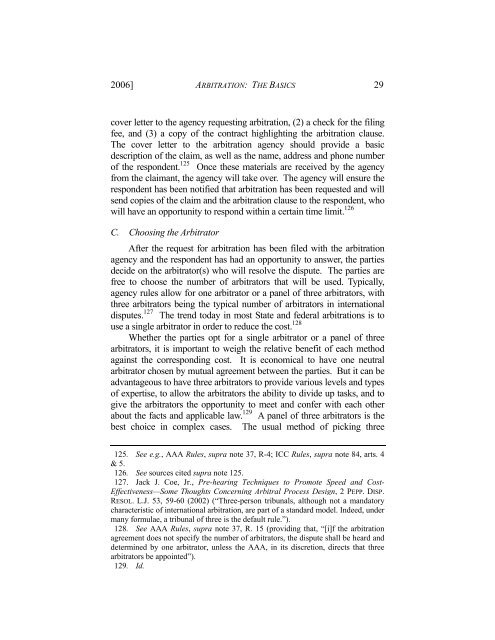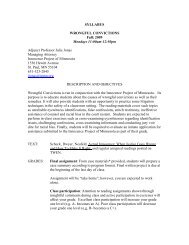2006/Vol. 5 No.1 - Hamline Law - Hamline University
2006/Vol. 5 No.1 - Hamline Law - Hamline University
2006/Vol. 5 No.1 - Hamline Law - Hamline University
Create successful ePaper yourself
Turn your PDF publications into a flip-book with our unique Google optimized e-Paper software.
<strong>2006</strong>] ARBITRATION: THE BASICS 29<br />
cover letter to the agency requesting arbitration, (2) a check for the filing<br />
fee, and (3) a copy of the contract highlighting the arbitration clause.<br />
The cover letter to the arbitration agency should provide a basic<br />
description of the claim, as well as the name, address and phone number<br />
of the respondent. 125 Once these materials are received by the agency<br />
from the claimant, the agency will take over. The agency will ensure the<br />
respondent has been notified that arbitration has been requested and will<br />
send copies of the claim and the arbitration clause to the respondent, who<br />
will have an opportunity to respond within a certain time limit. 126<br />
C. Choosing the Arbitrator<br />
After the request for arbitration has been filed with the arbitration<br />
agency and the respondent has had an opportunity to answer, the parties<br />
decide on the arbitrator(s) who will resolve the dispute. The parties are<br />
free to choose the number of arbitrators that will be used. Typically,<br />
agency rules allow for one arbitrator or a panel of three arbitrators, with<br />
three arbitrators being the typical number of arbitrators in international<br />
disputes. 127 The trend today in most State and federal arbitrations is to<br />
use a single arbitrator in order to reduce the cost. 128<br />
Whether the parties opt for a single arbitrator or a panel of three<br />
arbitrators, it is important to weigh the relative benefit of each method<br />
against the corresponding cost. It is economical to have one neutral<br />
arbitrator chosen by mutual agreement between the parties. But it can be<br />
advantageous to have three arbitrators to provide various levels and types<br />
of expertise, to allow the arbitrators the ability to divide up tasks, and to<br />
give the arbitrators the opportunity to meet and confer with each other<br />
about the facts and applicable law. 129 A panel of three arbitrators is the<br />
best choice in complex cases. The usual method of picking three<br />
125. See e.g., AAA Rules, supra note 37, R-4; ICC Rules, supra note 84, arts. 4<br />
& 5.<br />
126. See sources cited supra note 125.<br />
127. Jack J. Coe, Jr., Pre-hearing Techniques to Promote Speed and Cost-<br />
Effectiveness—Some Thoughts Concerning Arbitral Process Design, 2 PEPP. DISP.<br />
RESOL. L.J. 53, 59-60 (2002) (“Three-person tribunals, although not a mandatory<br />
characteristic of international arbitration, are part of a standard model. Indeed, under<br />
many formulae, a tribunal of three is the default rule.”).<br />
128. See AAA Rules, supra note 37, R. 15 (providing that, “[i]f the arbitration<br />
agreement does not specify the number of arbitrators, the dispute shall be heard and<br />
determined by one arbitrator, unless the AAA, in its discretion, directs that three<br />
arbitrators be appointed”).<br />
129. Id.
















